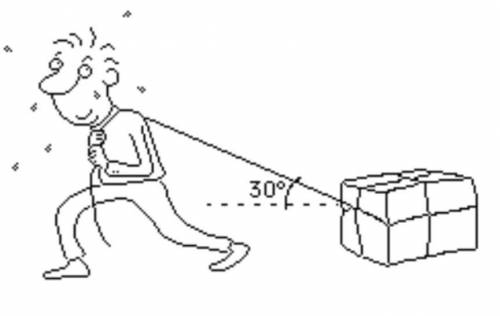
Physics, 02.02.2021 21:40 morgannwaldrupp
A person pulls a 50. kg box pictured below with a force of 100. N. The coefficient of kinetic friction is 0.15.
a. Sketch a force diagram for the box.
b. How much of the force acts in the direction of motion? How much energy is transferred (via working) by the person who pulls the box a distance of 10. m?
c. Is the box moving at constant speed? Explain how you know. What does this tell you about the kinetic energy Ek of the system?
d. How much energy is stored as internal energy due to friction in the pulling process over the 10.m?
What eventually happens to this energy?
e. Show that energy is conserved in the system, accounting for all the energy stored and transferred in the process.


Answers: 1
Another question on Physics

Physics, 21.06.2019 14:40
An implanted pacemaker supplies the heart with 72 pulses per minute, each pulse providing 6.0 v for 0.65 ms. the resistance of the heart muscle between the pacemaker’s electrodes is 550 ω. find (a) the current that flows during a pulse, (b) the energy delivered in one pulse, and (c) the average power supplied by the pacemaker.
Answers: 3

Physics, 21.06.2019 17:20
You have been called to testify as an expert witness in a trial involving a head-on collision. car a weighs 1515 lb and was traveling eastward. car b weighs 1125 lb and was traveling westward at 44.0 mph. the cars locked bumpers and slid eastward with their wheels locked for 22.5 ft before stopping. you have measured the coefficient of kinetic friction between the tires and the pavement to be 0.750 . how fast (in miles per hour) was car a traveling just before the collision? (this problem uses english units because they would be used in a u.s. legal proceeding.)
Answers: 3

Physics, 22.06.2019 17:00
Two manned satellites approaching one another at a relative speed of 0.550 m/s intend to dock. the first has a mass of 2.50 ✕ 103 kg, and the second a mass of 7.50 ✕ 103 kg. assume that the positive direction is directed from the second satellite towards the first satellite. (a) calculate the final velocity after docking, in the frame of reference in which the first satellite was originally at rest.(b) what is the loss of kinetic energy in this inelastic collision? (c) repeat both parts, in the frame of reference in which the second satellite was originally at rest. final velocity(d) loss of kinetic energy = ?
Answers: 2

Physics, 23.06.2019 03:30
First to answer will be the brainliest i need the answer asap
Answers: 1
You know the right answer?
A person pulls a 50. kg box pictured below with a force of 100. N. The coefficient of kinetic frict...
Questions

Biology, 04.11.2021 21:50

Mathematics, 04.11.2021 21:50

SAT, 04.11.2021 21:50

Mathematics, 04.11.2021 21:50



Health, 04.11.2021 21:50

Mathematics, 04.11.2021 21:50



Biology, 04.11.2021 21:50


Biology, 04.11.2021 21:50

History, 04.11.2021 22:00





Business, 04.11.2021 22:00





